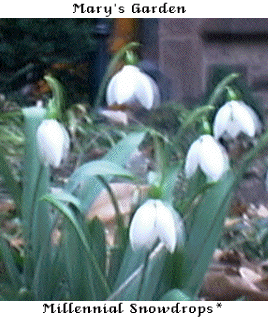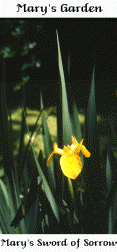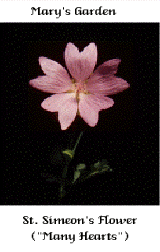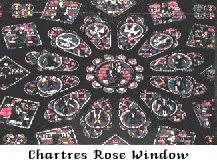John Stokes and Mary's Gardens
Flowers and Presentation of the Child Jesus
Seasonal Flower Reflections (Candlemas Bells)
– John S. Stokes Jr.
A number of the medieval Flowers of Our Lady have been associated with the feasts or seasons of the liturgical year for which they are in bloom, and for which their characteristic forms or colors have been seen as symbols.
Such flowers include Christmas Rose, Candlemas Bells, Annunciation Lily, Lent Lily, Easter Lily, Ascension Flower, Pentecost Flower, Corpus Christi Flower, Assumption Flower, All Saints Flower and also numerous flowers of the saints.
In the north temperate climatic zones of Europe and the United States one such flower of special significance for Mary Gardeners is the snowdrop or Candlemas Bells, Galanthus nivalis - the first bloom of the new growing season - named for its bloom around the time of Candlemas, the Feast of the Presentation of the Child Jesus in the Temple, February 2nd.
Accordingly, in mid-January each year we begin a close watch of weather forecasts and of our snowdrop plantings to see if a January thaw, moist soil and warming sunshine will provide the softened ground, moisture and warmth required to produce buds or blooms for Candlemas. If the blooms are late, we try for the next year a more southerly and protected planting; if early, one less southerly and more exposed to cold winds.
Because of its position at the beginning of the bloom season, Candlemas, February 2nd, has long been the European bellweather day on which predictions of coming spring weather are made, based on whether the badger emerges from his lair to see his shadow - a custom adapted in the United States for the same date as "Groundhog's Day".
Snowdrops, because of their first bloom in many areas, are symbols, more generally, of hope itself, giving rise to the ancient legend that in their desolation over the seemingly unending winter cold and winds and the death of plants displacing the continuous temperate summer of Eden - through the rupture of the original integrity and equilibrium of the sensitive attunement of the world soul by the effects of original sin - the merciful hope of spring was introduced through the discovery by Adam and Eve of the first snowdrop blooms.

While the Flowers of Our Lady are ever in bloom in the virtual gardens of the heart, when they bloom in nature and the garden, their reborn symbolism serves further to quicken and sustain reflection and meditation on the truths symbolized. Because of the close attention given to each flower's first bloom, to the duration of its blooming and to its care in the garden, the reflective quickening of its ever-present symbolism is almost continuous - supporting deeper and more extensive reflection and meditation on the truths symbolized than a reading of scripture, or the liturgy for a feastday, or a momentary focus among the multiple mysteries of the Rosary.
The truth symbolized by Candlemas Bells is that of Simeon's prophecy, at the Presentation of the infant Jesus in the Temple, of the co-redemptive piercing of Mary's soul by a sword of sorrow at the foot of the Cross (Luke 2:34, 35):
"And Simeon blessed them and said to Mary his mother:
Behold this child is set for the fall and for the
resurrection of many in Israel and for a sign which
shall be contradicted.
"And thy own soul a sword shall pierce, that, out of
many hearts thoughts may be revealed."

From our familiarity with the spear-like foliage of Iris, "Mary's Sword of Sorrow", symbolizing, for Good Friday, Mary's actual Co-redemption at the foot of the Cross, we note the similar tiny soul-piercing spears of the Snowdrop foliage, and see the Snowdrop buds or flowers as symbols of Mary's soul which was pierced - a dual symbolism brought to our attention through the discernment of Nanette Sears, prime-mover of the Mary Garden at St. Mary's Church, Annapolis.
Reflecting on this, we come to understand that as the graces of redemption flowed from the pierced heart of Christ on the Cross, so did the graces of openness and assent to the reception of these graces flow from the co-redemptive mediation of Mary, Mother of the Church, at the foot of the Cross, through her pierced soul and heart - by the reception or non-reception of which the thoughts of many hearts are revealed. We are to emulate Mary's "yes" to the graces of the Redemption as well as to those of the Incarnation.
In this we recall the discovery of St. Francis Xavier that the conversions from his missionary preachings were greater on days when, in praying for them the previous night before the Crucifix, he prayed also for the mediation by Mary, Co-redemptrix, standing at the foot of the Cross, for the graces for the opening of hearts to Christ's graces of conversion.
In the Liturgy of Hours, the Second Reading for the feast of the Presentation of Mary, from a sermon by St. Augustine, instructs us that:
"The Virgin Mary...the chosen one from whom our Savior
was born among men...believed by faith and conceived by
faith....
"Mary heard God's word and kept it, and so (was) blessed.
She kept God's truth in her mind, a nobler thing than
carrying his body in her womb. The truth and the body
were both Christ: he was kept in Mary's mind insofar as
he is truth, he was carried in her womb insofar as he
is man; but what is kept in the mind is of a higher
order than what is carried in the womb."

It is the graces of belief in Christ - to which she opened herself as a maiden, prior to the Annunciation - that Mary, her soul pierced by a sword of sorrow, nurturingly mediates for all hearts. Indeed, it is in this nurturing of the birth of Christ in hearts, minds and souls, that Mary first of all is Mother of the Church, of the Mystical Body of Christ - as proclaimed by Jesus to her and to the disciple John from the Cross (John 19:26, 27).
Reflecting further, we come more fully to understand the human equality of Mary as Co-redemptrix with Christ the Redeemer as a manifestation of her overall intimate union and close cooperation with him as human equal, on earth and continuing in heaven, in the total work of Redemption, Sanctification, Renewal and Kingdom - beginning with her privileged, prerogatived and freely, lovingly accepted role as his divinely conceiving and nurturing Mother.
From our belief in an all-just God, we conclude that there is no injustice to women involved in God becoming incarnate as man - any seeming injustice being the consequence of a failure to discern Mary's human equality with Jesus. Indeed, there was also a divine-human equivalency between Mary and Jesus in that the hypostatic union of the divine and human natures in the person of Jesus, true God and true man, was paralleled by Mary's espousal to God the Holy Spirit such that "the two became one", and the Holy Spirit was thus her spirit.
From the overall viewpoint of the divine purpose and will for Creation - of the eternal sharing of the divine goodness and action with humans - the co-redemptive immolative fruitfulness of Jesus and Mary together, and their general fruitfulness in grace, is the ultimate mirroring and sharing by human nature, created on earth in the divine image and likeness, male and female, of the eternal heavenly generation of the Holy Spirit in fruition of the eternal love and communion between the Father and the Son.
It could be said that, after Christ's Ascension and Mary's Assumption into Heaven, a general equivalence was established between men and women, such that women, through their endowed gift of nurturing, continue through their prayers and their acts of mercy, in emulation of and union with Mary and through her mediation, to give birth to Christ in hearts, minds and souls; while men, beginning with the Apostles, distribute Christ, under the consecrated species, so that he may be ever more fully present to those receiving them, in whom he has come to reside through Mary's giving spiritual birth.
Pope John Paul II has spoken of these united and equal continuations and extensions of Mary's Divine Motherhood in hearts and Christ's apostolic continuation in the sacraments as the Marian and Petrine Churches, in which he discerns the Marian Church as prior.
In the medieval cathedrals, the Marian Church was symbolized architecturally by the cathedral itself, named for Mary, and the Petrine Church by the altar and bishop's chair. Interiorly, the dominant rose window, symbolizing "the Rose wherein the Divine Word was made incarnate", clearly represented the Marian Church - as distinct from the subordinate Marian side altar and no rose window in many churches today.

Through the special endowment of women by the Creator as mothers and nurturers - so that a blessed virgin might conceive the Redeemer in her heart, mind and soul; might give him birth in the flesh; might nurture his growth in wisdom, grace and strength; and might nurture his birth and growth in the members of his Mystical Body - all women are likewise vocationally called to the fulfillment of their respective nurturing potentials for restoring Christ, giving birth to Christ, in every area of human activity: personal, familial, religious, social, economic, vocational and professional . . .
Or, stated in another way, God, having created women with the capability of motherhood and of motherly nurturing, in preparation for the giving birth by a divinely conceiving blessed virgin to the Divine Word Incarnate, thus endowed all women with the special potential and dignity of emulating, participating in and extending Mary's divine motherhood in hearts. In justice to men, lacking the fullness of womanly nurturing endowment, Jesus, from this viewpoint, therefore conferred on them the privilege of apostleship, of continuing and extending the human birth of Christ and his Crucifixion, under the consecrated species of bread and wine.
Those who judge as an injustice to women the reservation by the Roman Church of the privilege of the holy orders of the priesthood to men, appear not to comprehend the unique equivalent privilege of all women, through their created motherly and nurturing endowments, of participating, in grace, in Mary's divine maternity, nurturing and cooperation. From this viewpoint, those who do not appreciate the fullness of women's potential for Marian emulation, and who hold the erroneous belief that the differing divine endowments of man and women are an injustice, can be said to participate in what psychiatrist Alfred Adler has termed the "masculine protest" - the attempt to find the fullness of womanly potential in the emulation of men rather than in the development of the uniquely womanly potential in itself.
In attempting to find womanly fulfillment through participation in men's endowment of the privilege of Holy Orders, rather than in the development, in grace, of their own endowed unique motherly and nurturing spiritual potential - through union with Mary in the nurturing of the birth of Christ in human hearts - women indeed make the masculine protest.
On the other hand, once the just equivalence of the Marian and Petrine churches, of women's privileged Christ-nurturing endowment and potential, as well as men's ordainment by Christ to Holy Orders, is fully understood and appreciated, it is conceivable that the Magisterium of the Roman Church might then extend Holy Orders to women as an alternate mode of fulfillment, for those so called, of their womanly potential - as men may now consecrate themselves, with women, to the Sacred Heart of Jesus through the Immaculate Heart of Mary.
It is a massive omission and injustice in the history of the fallen world that men, through their endowment with superior strength, have largely discriminatively confined women and their nurturing potential, to child-bearing, home-making, domestic service, gardening and animal husbandry, and to caring work such as nursing and teaching - instead of esteeming and looking to their equal participation, with full exercise of their special nurturing potentials, in all areas of human activity.
This was emphasized by the Church in the Second Vatican Council:
"It devolves on humanity to establish a political,
social and economic order which will to an ever better
extent serve (humankind) and help individuals as well as
groups to develop in dignity proper to them.
"As a result very many persons are quite aggressively
demanding those benefits which with vividness they
judge themself deprived either through injustice or
unequal distribution. . .
" . . . While they have not yet won it, women claim for
themselves an equality with men before the law and in
fact."
- The Church in the Modern World, par. 9 and,
"The Church is proud to have glorified and liberated
woman, and in the course of the centuries, in diversity
of characters, brought into relief her basic equality
with man. But the hour is coming, in fact has come,
when the vocation of women is being achieved in its
fullness."
- Closing Address to Women
With such clear affirmation of the equality of men and women, and of their needed mutual contributions to human society and the building of God's Kingdom on earth, the question arises as to the basis on which, in the Roman Church, women continue to be excluded from the Holy Orders of the priesthood - especially since it has now been demonstrated in the Anglican Church that they serve there vocationally as priests and bishops equally with men.
This exclusion is based, scripturally, on Jesus' calling of only men as his apostles; while the argument for the ordination of women is that it would further the fullness of sharing of the divine goodness and action with humans, created to this end, male and female, according to the purpose of Creation, and that the appointment of only male apostles was not for all time but a prudent temporary accommodation of the Church in the male-dominated society of the time of Christ, continuing up until the present time.
Reflecting on this as we behold the symbolism of snowdrops in the Mary Garden - and fully respecting and appreciating the magisterium and teaching authority of the Roman Church, lovingly established by God as the source of religious truth for the world - it would appear to us that even if women are one day to be ordained in the Church, it would only be after the full human dignity and equality of Mary with Christ in the deposit of faith are appreciated and celebrated in the Church in the fullness of the anticipated dogmatic definition of Mary's co-redemption, advocacy and universal mediation, with Christ.
The foregoing reflection and meditation based on the snowdrop Candlemas symbolism of the sword of sorrow piercing Mary's soul illustrates the efficacy of the Flowers of Our Lady symbolism for meditation as one works in the Mary Garden.
The snowdrop, "Candlemas Bells", is further treasured by Mary-Gardeners in that it commemorates the heavenly birthday, the beginning of the eternal season of heavenly bloom, of Frances Crane Lillie, founder of the Woods Hole mother Mary Garden, who died on Candlemas, February 2nd, 1958.
* In preparing to post the graphics to this text (posted January 1st) on January 4th, we rejoiced to find these "Millennial Snowdrops" in bloom on the south side of St. Mark's Episcopal Church in center city Philadelphia, thanks to a late December and early January thaw.
Copyright Mary's Gardens, 2000
The John Stokes and Mary's Garden collection was transferred to the Marian Library in May 2013. In addition to his archives, manuscripts, artwork, and personal library, John S. Stokes also donated his extensive website. It was transferred to the Marian Library in early 2010. This particular entry is archived content original to Stokes' Mary's Gardens website. It is possible that some text, hyperlinks, etc. are outdated.